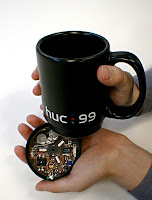 In Frankfurt there was today an expert meeting on RFID and ubicomp organized by the Fraunhofer ISI. The purpose was a discussion about the impact of RFID technologies. The organizers will use our input to inform the creation of a document of technology assessment for the German parliament. The majority of the participants came from companies developing RFID technology or system.
In Frankfurt there was today an expert meeting on RFID and ubicomp organized by the Fraunhofer ISI. The purpose was a discussion about the impact of RFID technologies. The organizers will use our input to inform the creation of a document of technology assessment for the German parliament. The majority of the participants came from companies developing RFID technology or system.
In the first part of my talk “RFID and Beyond” I highlighted results from two workshops where I was a co-organizer: PTA2006 and Pertec2007 held at the Pervasive and Percom conferences. The results were also published in 2 papers in the IEEE Pervasive Computing magazine, see [1] and [2]. After this I showed some future visions and scenarios, namely the Smart-Its & MediaCup (foto from Birgit at Teco) [3], the SensorKnife [4], and the aware goods project [5]. Michael Müller extended the idea of the first aware goods project with a mobile phone based prototype – which we still have not written up for publication.
For me the technology assessment in Germany seems still often very much centred on threats and looks much less at opportunities. Looking at developments in Asia and in particular in Korea (e.g. U-City) I hope politics in Germany will in the future more often see the positive sides, too. Technology assessment can become a means to find opportunities and ideas to support innovation. For me it seems that a lot of the risks people attribute to RFID are not based on scientific results – is appears rather media induced… Positive cases such as wireless key systems and transport tickets (basically RFID technology) are in widespread use without much problems and great value for users – but not present in the public discussion.
One interesting estimated was that about 200 parts of the several thousands (e.g. safety related parts, large parts, parts that are often stolen, expensive parts) per car will tagged with RFID in the next 10 years to ease logistics, production and maintenance.
[1] Schmidt, A.; Spiekermann, S.; Gershman, A.; Michahelles, F., “Real-World Challenges of Pervasive Computing“, Pervasive Computing, IEEE , vol.5, no.3pp. 91- 93, c3, July-Sept. 2006.
[2] Michahelles, F.; Thiesse, F.; Schmidt, A.; Williams, J. R.: Pervasive RFID and Near Field Communication Technology. In: IEEE Pervasive Computing, vol. 6, no. 3, pp. 94-96, c3, Jul., 2007.
[3] Hans-Werner Gellersen, Albrecht Schmidt, Michael Beigl: Multi-Sensor Context-Awareness in Mobile Devices and Smart Artifacts. MONET 7(5): 341-351 (2002)
[4] Matthias Kranz, Albrecht Schmidt, Alexis Maldonado, Radu Bogdan Rusu, Michael Beetz, Benedikt Hörnler, Gerhard Rigoll: Context-aware kitchen utilities. Tangible and Embedded Interaction 2007: 213-214
[5] Anke Thede, Albrecht Schmidt, Christian Merz: Integration of Goods Delivery Supervision into E-commerce Supply Chain. WELCOM 2001: 206-218



 The technical solutions were very different and ranged from a dismantled keyboard to a system using a micro-controller, from a two-way mirror with display behind to direction detection in front of an advert. Even though the prototypes were fairly simple most of them showed impressively how much of an idea a functional prototype can transport.
The technical solutions were very different and ranged from a dismantled keyboard to a system using a micro-controller, from a two-way mirror with display behind to direction detection in front of an advert. Even though the prototypes were fairly simple most of them showed impressively how much of an idea a functional prototype can transport.

